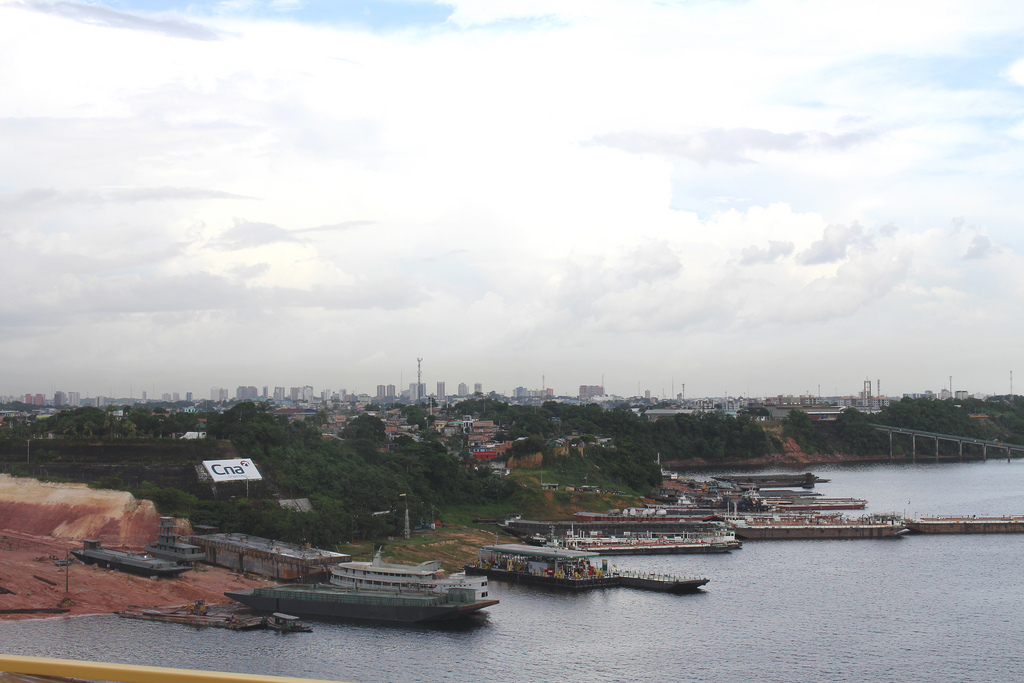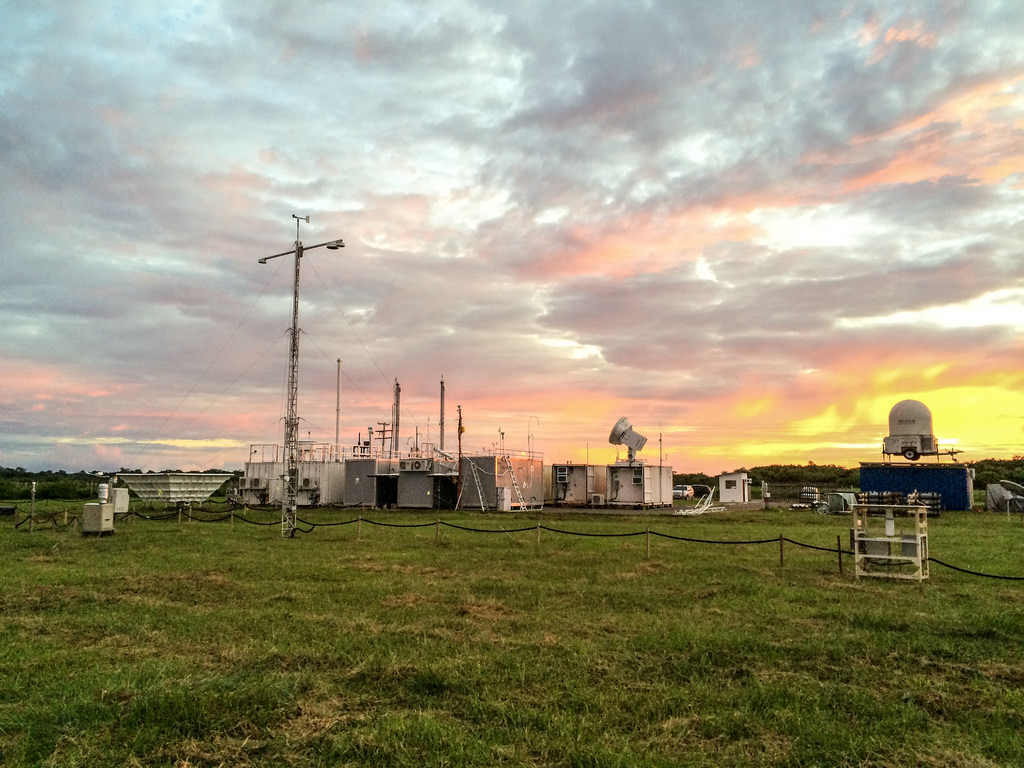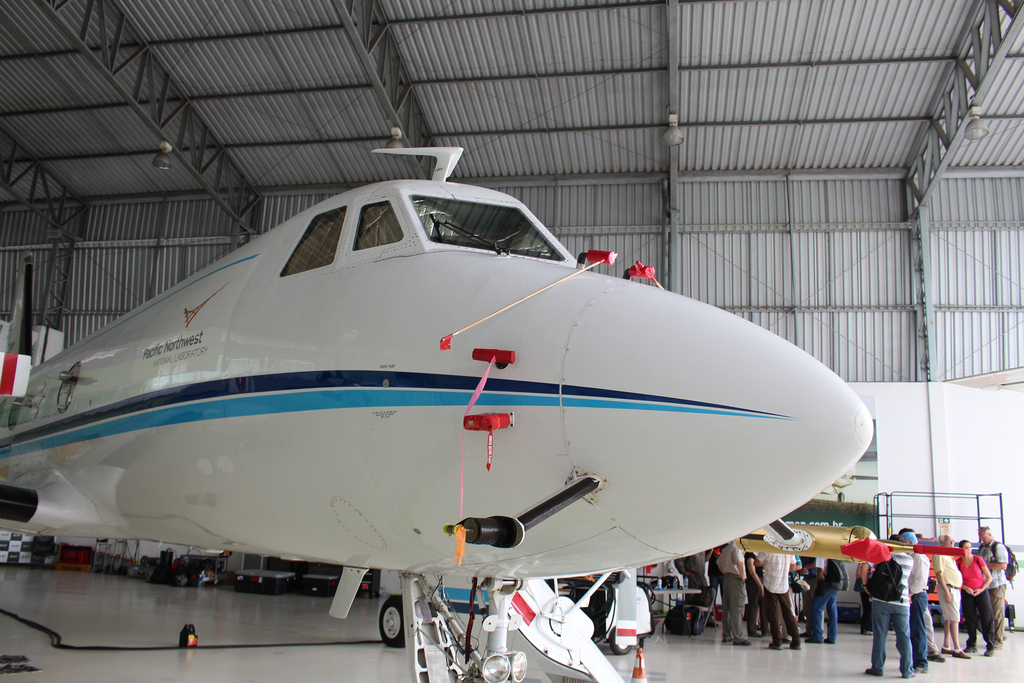Within a Pristine Tropical Forest, an Urban Pollution Plume
Published: 12 May 2017
Atmospheric researchers sharpen comparative measurements with low-flying aircraft

The Amazon rainforest is two-thirds the size of the continental United States and an immense repository of carbon comprised of several hundred billion trees. Its green expanse is bisected by the Amazon River, a “river sea” so wide in places that its wet-season width reaches 100 kilometers.
There is only one major urban center within this vastness of Brazilian rainforest: Manaus, a heavily developed city of 2.5 million surrounded by largely undisturbed tree cover—much like a green ocean. During the Green Ocean Amazon (GoAmazon2014/15) campaign, atmospheric researchers from around the world took advantage of this juxtaposition of the polluted and the pristine. Within an understudied yet climate-consequential tropical environment, they studied the susceptibility of gases, aerosols, clouds, and rainfall to pollution from human activities like power plants and biomass burning.
A paper in the latest issue of the Bulletin of the American Meteorological Society draws upon observations from the campaign’s low-flying aircraft. (There were also nine instrumented ground observation sites, one of which featured the first ARM Mobile Facility.) The authors delve into comparative measurements of emissions that originate as biogenic volatile organic compounds (BVOCs) from the forest canopy and show how these are transformed by the plume of emissions injected into the air by the polluted conditions of Manaus.
From One Air Age to Another

Lead author Scot T. Martin, an aerosol particles researcher at Harvard University, was joined by 57 co-authors from Brazil, Finland, Germany, Japan, and the United States. He described the paper as “a very broad survey” and invited readers to see it as a kind of science time travel story. The “unique laboratory” of the Manaus-forest juxtaposition, he says, enabled airborne measurements to record highly polluted modern conditions right alongside the nearly pure atmospheric conditions like those that predominated centuries ago.
During zig-zagging legs of flight, plane-based instruments recorded 300 particles per cubic centimeter in some areas, where “you are in the year 1750,” says Martin. Over Manaus, the same instruments put you fully back into the 21st century, with air grabs scoring a hundred times higher. The Brazilian city, he says, is “a fire hose shooting particles into the Amazonian atmosphere.”
Such dramatic shifts within the space of just one airplane flight are not possible anywhere else in the world, says Martin. Taking airborne measurements in the mid-continental United States, for instance, would yield a blanket average of about 2,000 particles per cubic centimeter: not useful if you are doing comparative atmospheric science. Over Kansas, signs of an ancient atmosphere are gone forever.
GoAmazon’s comparative data are useful for seeing how BVOCs are transformed by the atmospheric oxidant cycle; how that cycle is altered by pollutants; how chemical products from those pollutants are turned into aerosol particles, which affect cloud condensation nuclei activity; and the data are also good for seeing how cloud properties and rainfall differ in a pristine regime compared to a polluted one.
Research like this illuminates how things work in the tropics compared to the Earth’s more widely studied temperate regions. But can global inferences be drawn from GoAmazon? That remains to be seen, says Martin—even though “the Amazon itself is an important single actor in the climate realm.” Climate reflects global flows of joules (energy) and water, he adds, “and a large fraction of that happens in the Amazon.”
From the Air, Some Vertical Context

Martin is quick to add how vital airborne measurements were to the comparative science at hand—including data from the Gulfstream-159 (G-1) research aircraft operated by the U.S. Department of Energy’s Atmospheric Radiation Measurement (ARM) Climate Research Facility. For one, says co-author Jennifer Comstock, the aircraft “adds a vertical profile context that is difficult to measure on the ground.”
She is an atmospheric scientist at the Pacific Northwest National Laboratory (PNNL), and was aboard the G-1 during both phases of GoAmazon2014/15. The three-hour rides were turbulent and hot, says Comstock, but the data was terrific—along with the view of the pristine forest and the polluted city. She studied the differences in cloud droplet size distribution in clean and polluted environments. The research setting, says Comstock, allowed for “a really unique opportunity to isolate these differences.”
During the campaign, the G-1 flew both of the IOPs, or intensive operational periods: 16 flights (43 hours) during the wet season (February 15 to March 28, 2014) and 19 flights (53 hours) during the dry season (September 1 to October 15, 2014). The plane also flew relatively slowly—a research speed of 100 meters per second. And it flew quite low (thus the turbulence) in order to capture natural emissions from the forest canopy; its average operating altitude was about 500 meters.
At home, the G-1 resides in a hangar near PNNL, where it is staffed, instrumented, and maintained by the ARM Aerial Facility (AAF). The airborne component of GoAmazon took three years to organize, says AAF manager Beat Schmid, and it was the G-1’s most logistically difficult air campaign in a decade of flying. While there, “the heat outside and in the cabin was the main challenge,” he says. “If you never fly high, you never really have a chance to cool off.”
But GoAmazon “was an extremely successful campaign for the G-1,” says Schmid, an atmospheric scientist based at PNNL. So far it has spun off at least six papers, including one in Nature, he says, and is bound to produce more.
The duration of GoAmazon, and its comprehensive data, foretell a long run of coming publications.
Martin says the data sets demonstrate how anthropogenic (human) activities can strongly perturb the physical and chemical cycles that regulate the climate features of the Amazon basin. Comparative data from inside and outside the urban plume also show a greatly accelerated oxidant cycle, explained in large part by enhanced concentrations of air-polluting nitrous oxides.
The same Manaus plume significantly altered the microphysical properties of some cloud types in the region. Add to this some other trends in Amazonia not addressed during the campaign: increasing fires within the forest cover—and not just at its southern edge; demands for power going up 20 percent a year, a spur to more pollution; and fast-growing smaller cities, each one a potential mini-Manaus.
The science of GoAmazon and other efforts is strong, and at best, will help influence future development in the Amazon, says Martin. “That’s my pipe dream.”
The ARM Climate Research Facility is a DOE Office of Science user facility. The ARM Facility is operated by nine DOE national laboratories, including Pacific Northwest National Laboratory.
Keep up with the Atmospheric Observer
Updates on ARM news, events, and opportunities delivered to your inbox
ARM User Profile
ARM welcomes users from all institutions and nations. A free ARM user account is needed to access ARM data.


















